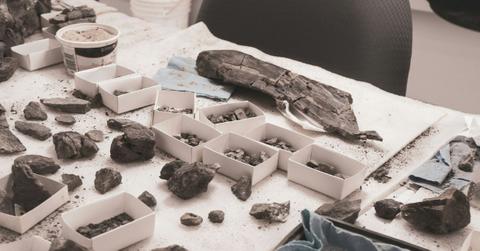Amateur Archaeologist Stumbles Upon 1.8-Million-Year-Old Fossil on Beach — 'I Was in Disbelief and Excited'

The fossil is said to be from 1.8 million years ago.
An amateur fossil enthusiast stumbled upon an extraordinary find.
Chris Bien, a 56-year-old resident of Goring-by-Sea, West Sussex, England, was strolling along the shores of Holland-on-Sea, Essex, when her eye landed on a peculiar sight amidst the gravel near the water's edge: a curious wavy line.
"It caught my eye, almost like a beckoning signal," Bien recalled. "At first glance, I suspected it might be a tooth due to its distinctive pattern. I began to unearth it with my hands, but the depth at which it lay necessitated more than just manual labor."
Joined by her husband, they embarked on a dig, unearthing what turned out to be a fully fossilized tooth. For Bien, the discovery, which can be seen here, was a stroke of serendipity, as earlier that day, she had whimsically declared to her husband, "I'm going to find a mammoth's tooth."
Although North Essex beaches are renowned for harboring fossilized treasures, stumbling upon one still managed to astonish Bien.
"I was in disbelief and excited — while we were digging it out I was hoping it was a mammoth tooth but I kept saying to my husband: ‘It can’t be.’”
Their elation peaked as they stood on the beach, tooth in hand, exchanging laughter at the magnitude of their find.
The tooth, estimated to be from the steppe mammoth, one of the largest mammoth species, measures between six-and-a-half to seven inches in both depth and width, with a weight of approximately 4.4 pounds.
- What Lies Beneath: NASA Scientist Believes Aliens May Have Found 'Perfect' Hiding Spot in Earth's Oceans
- Global Threat: Russia Insider Warns West of 'World War Using Nuclear Weapons' Amid Escalating Support for Ukraine
- Countdown to Disaster? Ex-NATO Official Warns Russia, Iran and China Could Wage WWIII in Just Years
Roaming the earth 1.8 million years ago, the steppe mammoth is an ancestor of the iconic wooly mammoth.
Speculating that the fossil might represent only half of a tooth, Bien intends to preserve it meticulously. Her plan involves soaking it in distilled water for several weeks before treating it with preservation glue and ethanol.
Never miss a story — sign up for the Front Page Detectives newsletter. Be on the scene the moment news breaks.
"I feel a responsibility to share the profound historical significance of this discovery. As an amateur archaeologist and a member of the Hove Archaeological Society for nearly two decades, it's imperative to document and disclose our findings," Bien affirmed. Yet, she also harbors a desire to cherish and exhibit the tooth, reflecting her passion for preservation and education, evident in her volunteer work at a museum in Worthing.
“I want people to know about the deep, rich history behind this find — when you’re an archaeologist, it’s your duty to report your finds,” said Bien, who has been a member of the Hove Archaeological Society for the last 17 years.
“But I would also love to keep it and display it,” Bien, who also volunteers at a museum in Worthing explained.
Become a Front Page Detective
Sign up to receive breaking
Front Page Detectives
news and exclusive investigations.
